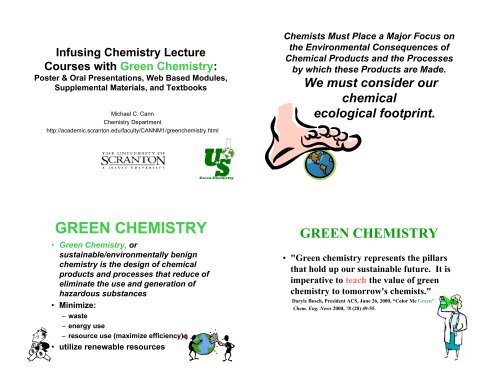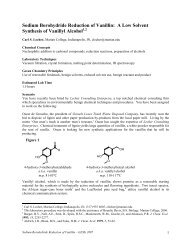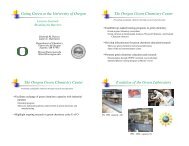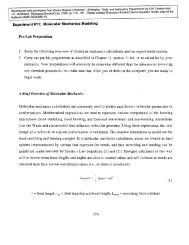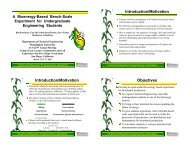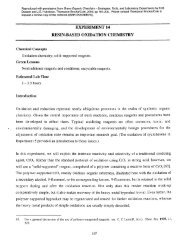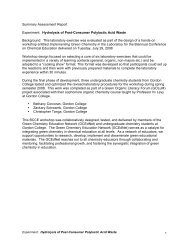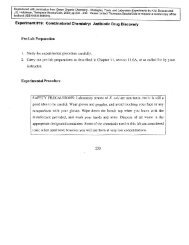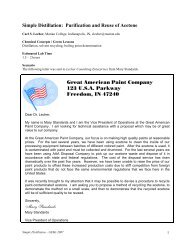Power Point Presentation (PDF) - Green Chemistry Center
Power Point Presentation (PDF) - Green Chemistry Center
Power Point Presentation (PDF) - Green Chemistry Center
You also want an ePaper? Increase the reach of your titles
YUMPU automatically turns print PDFs into web optimized ePapers that Google loves.
Infusing <strong>Chemistry</strong> Lecture<br />
Courses with <strong>Green</strong> <strong>Chemistry</strong>:<br />
Poster & Oral <strong>Presentation</strong>s, Web Based Modules,<br />
Supplemental Materials, and Textbooks<br />
Michael C. Cann<br />
<strong>Chemistry</strong> Department<br />
http://academic.scranton.edu/faculty/CANNM1/greenchemistry.html<br />
Chemists Must Place a Major Focus on<br />
the Environmental Consequences of<br />
Chemical Products and the Processes<br />
by which these Products are Made.<br />
We must consider our<br />
chemical<br />
ecological footprint.<br />
GREEN CHEMISTRY<br />
• <strong>Green</strong> <strong>Chemistry</strong>, or<br />
sustainable/environmentally benign<br />
chemistry is the design of chemical<br />
products and processes that reduce of<br />
eliminate the use and generation of<br />
hazardous substances<br />
• Minimize:<br />
– waste<br />
– energy use<br />
– resource use (maximize efficiency)<br />
• utilize renewable resources<br />
GREEN CHEMISTRY<br />
• "<strong>Green</strong> chemistry represents the pillars<br />
that hold up our sustainable future. It is<br />
imperative to teach the value of green<br />
chemistry to tomorrow's chemists."<br />
Daryle Busch, President ACS, June 26, 2000, “Color Me <strong>Green</strong>”<br />
Chem. Eng. News 2000, 78 (28) 49-55.
ENVIRONMENTAL<br />
CHEMISTRY<br />
• Poster/Oral <strong>Presentation</strong> on one of the<br />
PGCC Award Winning Proposals 1996<br />
Cann, Michael C., J. Chem. Ed. 1999, 76 (12), 1639-1641.<br />
REAL-WORLD CASES IN<br />
GREEN CHEMISTRY<br />
• ACS/EPA <strong>Green</strong> <strong>Chemistry</strong> Educational Materials<br />
Development Project, 1998<br />
• Compilation of materials on real-world green<br />
chemistry (based on PGCC) in a format that can<br />
be used for educational purposes<br />
• Each case acts as an informational<br />
resource for instructors to use in<br />
greening their courses<br />
• Marc Connelly<br />
http://www.acs.org/portal/<strong>Chemistry</strong>?PID=acsdisplay.html<br />
&DOC=education\greenchem\cases.html<br />
Michael C. Cann and Marc E. ConnellyUniversity of Scran<br />
Real-World Cases in <strong>Green</strong> <strong>Chemistry</strong><br />
Real-World Cases in <strong>Green</strong> <strong>Chemistry</strong> Michael C. Cann and Marc E. ConnellyUniversity of ScrantonThe Concept of Atom Economy g,o,e,in How Many Reactant Atoms are Incorporated into the Desired Product and How
MAINSTREAMING GREEN<br />
CHEMISTRY<br />
• Insertion of green chemistry into<br />
mainstream chemistry courses<br />
• Need faculty who teach these courses to<br />
develop modules on green chemistry related<br />
to topics already covered in their course<br />
• Make it easy (lower E act ) for other<br />
faculty to do the same;<br />
place materials on the web<br />
WEB BASED GREEN CHEMISTRY<br />
MODULES FOR SPECIFIC<br />
CHEMISTRY COURSES<br />
• Major support-The Camille and Henry Dreyfus<br />
Foundation; Additional support-ACS/EPA,<br />
University of Scranton<br />
• T. Dickneider, T. Foley, D. Marx, D. Narsavage-<br />
Heald, J. Wasilewski<br />
(The “<strong>Green</strong> Machine”)<br />
Cann, M. C. "<strong>Green</strong>ing the <strong>Chemistry</strong> Curriculum at the University of<br />
Scranton," <strong>Green</strong> <strong>Chemistry</strong>, 2001, 3, G23<br />
Cann, M.C., Dickneider, T. A., "Infusing the <strong>Chemistry</strong> Curriculum with<br />
<strong>Green</strong> <strong>Chemistry</strong> Using Real-World Examples, Web Modules, and<br />
Atom Economy in Organic <strong>Chemistry</strong>," J. Chem. Ed., 2004, 81, 977<br />
GREEN CHEMISTRY<br />
MODULES FOR SPECIFIC<br />
CHEMISTRY COURSES<br />
• General -Surfactants for CO 2<br />
• Organic -Atom economy<br />
• Inorganic –Activators of hydrogen<br />
peroxide for green oxidation<br />
• Biochemistry –Confirm, Mach 2 and<br />
Intrepid pesticides<br />
• Advanced Organic –Elimination of<br />
Chlorine in NAS<br />
GREEN CHEMISTRY<br />
MODULES FOR SPECIFIC<br />
CHEMISTRY COURSES<br />
• Polymer –Polyaspartic acid<br />
• Industrial –Petretec polyester regeneration<br />
• Environmental –Sea-nine antifoulant<br />
• Chemical Toxicology –Confirm,<br />
Mach 2, and Intrepid
<strong>Green</strong> <strong>Chemistry</strong><br />
–Environmental <strong>Chemistry</strong><br />
• Ozone hole and troposheric air pollution: carbon dioxide as a<br />
replacement for CFCs and hydrocarbon blowing agents;<br />
surfactants for carbon dioxide so that carbon dioxide can be<br />
used to replace VOCs.<br />
• Pesticides: readily biodegradable marine antifoulant as<br />
replacement for tributyltin oxide; selective pesticides as<br />
replacements for broad spectrum pesticides.<br />
• Toxic organic chemicals (e.g. dioxins): activators of hydrogen<br />
peroxide to replace chlorine bleaching agents.<br />
• Polluted water and sewage treatment: biodegradable scale<br />
inhibitors and dispersing agents as a replacement for<br />
polyacrylate polymer.<br />
• Solid waste, landfills and closed loop recycling: Petretec<br />
process for conversion of PET back into its monomers and<br />
reformation into virgin PET.<br />
Environmental <strong>Chemistry</strong><br />
Baird & Cann<br />
• Introduction to <strong>Green</strong> <strong>Chemistry</strong> –Atom<br />
economy; synthesis of ibuprofen.<br />
• Ozone –CO 2 as a blowing agent; Harpin as a<br />
replacement for methyl bromide fumigant.<br />
• Tropospheric pollutants –CO 2 surfactants.<br />
• <strong>Green</strong>house gases –scCO 2 in<br />
photolithography.<br />
• Energy/petroleum –biodegradable polymers<br />
from renewable resources.<br />
• Pesticides –selective pesticides; termite control/<br />
reduced risk pesticides.<br />
Environmental <strong>Chemistry</strong><br />
Baird & Cann<br />
• Toxic organics –non-chlorine bleaching agents,<br />
H 2 O 2 activators<br />
• Water pollution/purification –enzymatic<br />
preparation of cotton textiles; biodegradable<br />
chelating agents<br />
• Heavy metals –removal of lead from automobile<br />
paint; removal of arsenic and cadmium from<br />
pressure treated wood<br />
• Solid waste –biodegradable antiscalant;<br />
recylable carpeting
<strong>Green</strong> <strong>Chemistry</strong> Endeavors<br />
at Scranton<br />
• “<strong>Green</strong>ing” existing chemistry textbooks.<br />
– “Organic <strong>Chemistry</strong>, Solomons & Fryhle, Wiley<br />
– “<strong>Chemistry</strong> Foundations and Applications,” Macmillan<br />
• Translation of our web-based <strong>Green</strong><br />
<strong>Chemistry</strong> Modules into Spanish &<br />
Portuguese.<br />
• The business side of green chemistry.<br />
– Survey of PGCC applicant<br />
– Infusion into business courses<br />
• Bringing green chemistry to the high<br />
school and secondary school level.<br />
• Integrating sustainability throughout<br />
our campus<br />
http://matrix.scranton.edu/sustainability/default.shtml


